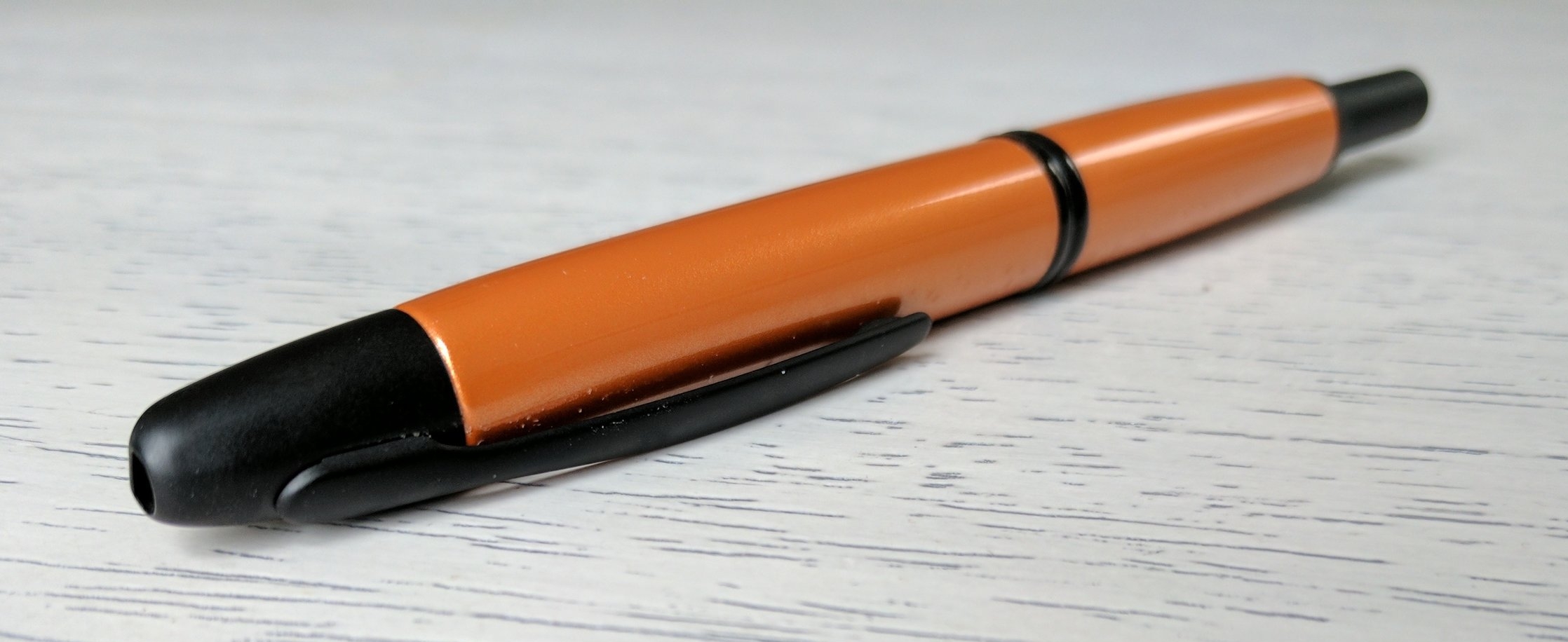When I think of U.S. campus bookstores, I imagine overly-priced flimsy spiral notebooks, cheaply made coffee mugs, and sports apparel. This isn't a place to go to find the best writing instruments or paper. Japanese campus stores are vastly different. I visited Kyoto Sangyo University, for a conference in 2015, and was amazed by the campus store. There were rows upon rows of notebooks, as well as a wide range of pens and pen cases. While this was drool-worthy in itself, it was the pen at the bottom of a glass display case that caught my attention. I had never seen a Pilot Vanishing Point in person before, but there it sat, shining in the florescent store lights. $200 seemed like an outrageous price at the time, but the experience cemented the Vanishing Point in the back of my mind.
Fast forward a year and my pen hobby has teetered towards obsession. I worked my way up to the Vanishing Point over time and finally decided to pick up a Desert Orange Vanishing Point from Amazon. It's difficult to gage the orange color from pictures, but it's a subtle orange with shades of brown. Since this color is a part of the Metallic series, it has small flecks in the pen body which shimmer in the light. Overall, I wish that the orange was more vibrant, but it's still my favorite color out of the bunch.
The Pilot Vanishing Point's metal body gives it a nice heft. Although the smooth lacquered body would be slippery to grip on its own, the matte black tip provides a subtly-textured surface that grips well. The Vanishing Point is capless and uses a nock mechanism (the clicky thing) to reveal the tip, similar to a standard capless ballpoint. The pen clip is attached to the pen body at the grip area and has two small finger indentations, which allow for fingers to slide into place and grip the pen comfortably. The clip was my biggest concern, but I've been pleasantly surprised by how comfortable the pen is to hold. I am right-handed, so lefties should definitely try the pen themselves or refer to a lefty review before purchasing.
There are only a few capless fountain pens in the wild for a reason; they're hard to design. Pens like the early versions of the Lamy Dialog have received negative reviews, due to dried out nibs, but the Vanishing Point seems to have gotten this right. Depressing the nock pushes the nib through a small metal door, which moves out of the way and exposes the nib. Clicking the nock again recesses the nib and closes the metal door, keeping air out of the pen chamber. Side note, the nock's click is extremely satisfying.
The nib for the Desert Orange Vanishing Point is a sleek black color, but the nib color varies by body color style. Although the pen comes with a gold nib, there's little flex, since the nib itself has to be slender enough to retract into the pen. Nib units can be easily swapped between Vanishing Points, much like a traditional ink refill in a capless ballpoint pen. I chose the medium nib, since Japanese nibs run finer than their European counterparts, and the medium nib is on par with a western fine nib. The writing experience is smooth, although the nib has more of a marker feel on paper, compared to my Lamy 2000, which feels like writing on glass.
Speaking of the Lamy 2000, I'm sure that some readers of this review will want to know whether they should choose a Lamy 2000 or a Vanishing Point, since both are similar price points and popular choices when leveling up your pen game. The short answer to this question is that you should choose the pen that has the best features for you. The Vanishing Point's capless design makes it easy to grab and use one-handed, and you can store it in a pocket or bag without fear of losing the cap. The Vanishing Point uses a cartridge or converter, so it holds much less ink than the Lamy 2000, and the clip grip may be a turnoff for some users. The grip itself is a touch wider than that of the Lamy 2000. The base model of the Lamy 2000 comes in one color, while the Vanishing Point come in a wide range of colors. All of these factors are worth considering, but there is no objective answer to which pen is better. Both the Pilot Vanishing Point and Lamy 2000 are excellent pens for the price.















